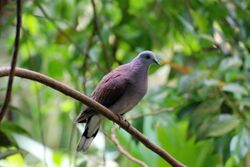Biology:Nesoenas
| Nesoenas | |
|---|---|

| |
| Malagasy turtle dove (N. picturata) at Zürich Zoo (Switzerland ) | |
| Scientific classification | |
| Domain: | Eukaryota |
| Kingdom: | Animalia |
| Phylum: | Chordata |
| Class: | Aves |
| Order: | Columbiformes |
| Family: | Columbidae |
| Subfamily: | Columbinae |
| Genus: | Nesoenas Salvadori, 1893 |
| Synonyms | |
| |
Nesoenas is a bird genus in the pigeon and dove family, Columbidae. It is often included with the typical turtle-doves in Streptopelia or the typical pigeons (Columba). By those who accepted it, it was usually treated as monotypic, containing only the pink pigeon (N. mayeri) of Mauritius.[1]
Recent cladistic analysis of mtDNA cytochrome b, cytochrome c oxidase subunit I and NADH dehydrogenase subunit 2, as well as nuclear β-fibrinogen intron 7 sequence data, combined with a distinct morphology and behaviour, suggest that the genus is valid but not monotypic. Nesoenas should actually refer to the apparently monophyletic lineage of Columbidae from the Madagascar –Mascarenes region. Though most closely related to both Streptopelia and Columba, it cannot be unequivocally be considered a basal branch of either.[2][1]
Separating from its relatives in Columba and Streptopelia probably in the Late Miocene, perhaps some 8–7 million years ago, this lineage has characteristic vocalizations, and a generally reddish-hued plumage with a darker back and lighter underparts and head. At least in the living species, the rump and tail are colored contrastingly. The living species differ much in size, and the pink pigeon (and presumably its extinct Réunion relative too) is notably large and apomorphic compared to the rather plesiomorphic but widespread Malagasy turtle dove (N. picturata). But even though the latter species has display plumage on the neck similar to that of several Columba and Streptopelia, these feathers have somewhat bifurcated tips, unlike in the two related genera. Theoretically, the smaller lineage could be separated as Homopelia, but most modern authors would probably consider this oversplitting.[1]
Species
The genus contains three species, of which one is now extinct:[3]
- Malagasy turtle dove or Malagasy turtle-dove, Nesoenas picturatus
- † Rodrigues pigeon, Nesoenas rodericanus – extinct (before 1690?)
- Pink pigeon, Nesoenas mayeri
Another extinct species may belong to this genus:
- † Mauritian turtle dove, Nesoenas cicur
References
- ↑ 1.0 1.1 1.2 Cheke, Anthony S. (2005). "Naming segregates from the Columba–Streptopelia pigeons following DNA studies on phylogeny". Bulletin of the British Ornithologists' Club 125 (4): 293–295. https://www.biodiversitylibrary.org/page/40056602. Researchgate
- ↑ Johnson, K.P.; De Kort, S; Dinwoodey, K.; Mateman, A.C.; Ten Cate, C.; Lessells, C.M.; Clayton, D.H. (2001). "A molecular phylogeny of the dove genera Streptopelia and Columba". Auk 118 (4): 874–887. doi:10.1642/0004-8038(2001)118[0874:AMPOTD2.0.CO;2]. https://sora.unm.edu/sites/default/files/p00874-p00887.pdf.
- ↑ Gill, Frank; Donsker, David; Rasmussen, Pamela, eds (2020). "Pigeons". IOC World Bird List Version 10.1. International Ornithologists' Union. https://www.worldbirdnames.org/bow/pigeons/. Retrieved 15 March 2020.
Wikidata ☰ Q2351447 entry
 |

